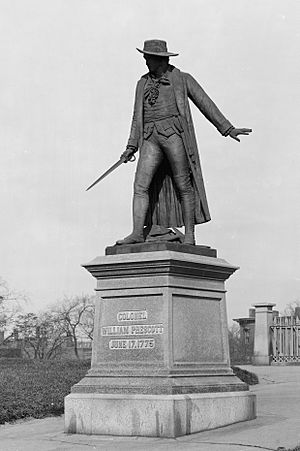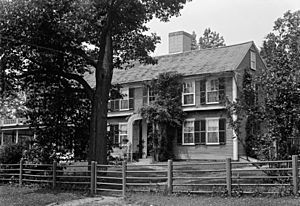William Prescott facts for kids
Quick facts for kids
William Prescott
|
|
|---|---|

Statue of Colonel William Prescott in Charlestown, Massachusetts.
|
|
| Born | February 20, 1726 Groton, Province of Massachusetts Bay |
| Died | October 13, 1795 (aged 69) Pepperell, Massachusetts |
| Allegiance | |
| Service/ |
|
| Years of service | 1745–1786 |
| Rank | |
| Unit | Continental Army |
William Prescott (born February 20, 1726 – died October 13, 1795) was an American colonel during the American Revolutionary War. He is famous for leading the American forces at the Battle of Bunker Hill. Prescott is well-known for telling his soldiers, "Do not fire until you see the whites of their eyes." This command meant that his troops should wait until the enemy was very close. Waiting made their shots more accurate and deadly, and it helped them save their limited ammunition. People still discuss whether he was the first to say this famous line.
Contents
Early Life and Military Service
William Prescott was born in Groton, Massachusetts. At that time, the area now known as East Pepperell was part of Groton. His parents were Benjamin and Abigail Prescott. On April 13, 1758, he married Abigail Hale. They had one child, who was also named William. Prescott owned a house in Pepperell, Massachusetts.
Prescott first served in the local militia during King George's War. In 1745, he took part in the Siege of Louisbourg. He served under a commander named William Pepperrell. It is thought that Prescott might have helped name the town of Pepperell, Massachusetts. The town was named after his commander when it separated from Groton in 1753. In 1755, he also fought in the French and Indian War at the Battle of Fort Beauséjour. After this war, he was offered a job in the British Army, but he chose not to join.
Fighting in the American Revolution
In 1774, towns in Massachusetts began forming their own militia groups. Prescott became a colonel, leading the Pepperell company. On April 18, 1775, news spread that British troops were marching towards Concord. Prescott quickly gathered his companies from Pepperell, Hollis, and Groton. They rode towards Concord, but they arrived too late to join the battles that day. However, they became part of the American army that then surrounded Boston.
American leaders soon learned that the British planned to take control of high ground near Dorchester Heights and Charlestown. Prescott was chosen to lead 1,200 men to the Charlestown peninsula. Their mission was to build defenses on Bunker Hill on the night of June 16, 1775. They actually built their main defenses on Breed's Hill, which was lower and closer to the harbor.
The next day, Prescott's troops were tired from building their defenses. They also had very little ammunition. They became the main part of the American defense when the British attacked. The British ships began firing at 4 a.m., and the ground attack started at 3 p.m. Prescott's men bravely fought back two British attacks on their fort, called a redoubt. When the British attacked a third time, his men were almost out of ammunition. After firing one last time, he ordered them to leave the redoubt. Prescott was one of the last to leave, using his ceremonial saber to defend himself.
Even though the British took Bunker Hill, the American forces caused many casualties. The British lost half of their attacking force, with many killed or wounded. Prescott is seen as a key leader in this battle. He kept his less-trained militia soldiers well-organized and disciplined.
After the battle, the Second Continental Congress created the Continental Army. George Washington was sent to lead the forces surrounding Boston. Prescott was made a colonel, and his unit became the 7th Continental Regiment. His regiment fought in the 1776 defense of New York. He later took part in the 1777 Saratoga campaign. He is even shown in a famous painting called Surrender of General Burgoyne at Saratoga. This painting hangs in the U.S. Capitol Rotunda. He may have left military service because of injuries from a farm accident.
Later Years
After the war, Prescott served in the Massachusetts General Court, which is like a state legislature. He also helped the militia put down Shays' Rebellion in 1786. His brother, Oliver Prescott, was also important in stopping this uprising. William Prescott died in 1795 in Pepperell.
Legacy and Honors
- A statue of William Prescott was made for a memorial at the Battle of Bunker Hill.
- The former town of Prescott, Massachusetts, was named in his honor. This town was removed in 1938 when the Quabbin Reservoir was built. The land is now called Prescott Peninsula.
- Prescott's house is in North Pepperell, Massachusetts.
- A small granite monument in Cambridge, Massachusetts, marks where Prescott and 1,200 Patriot men gathered before marching to Bunker and Breed's Hills.
It is interesting to note that Prescott Street in Cambridge is not named after General William Prescott. It is named after his grandson, William Hickling Prescott. This grandson became a famous historian and author. The city of Prescott, Arizona, is also named after his scholarly grandson.
Images for kids
See also
 In Spanish: William Prescott para niños
In Spanish: William Prescott para niños






